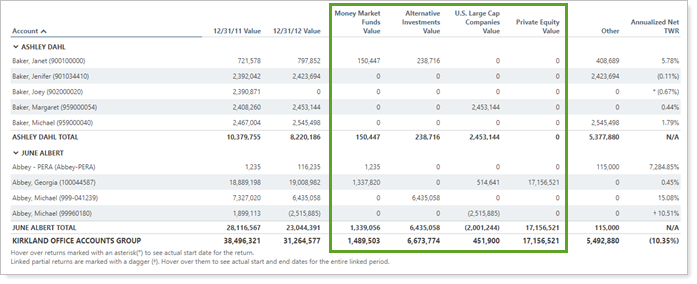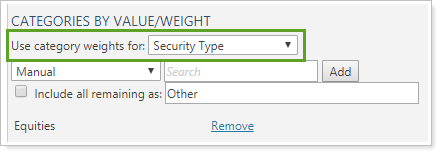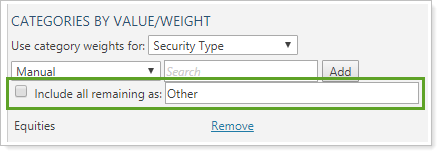Contents
|
How Categories by Value/Weight Works |
How Categories by Value/Weight Works
| Applies to: | ||
|---|---|---|
| ✔ Dynamic |
✔ Client Portal |
|
The settings described on this page appear when you add the Category Value(s)/Weight(s) column to the Selected columns list. When you add Category Values(s)/Weight(s) to the Comparative Review report, you can then add one or more categories to the Comparative Review report and display the value and weight for one category next to each other before showing values for the next category.
This option displays value and weight together for each category on the report.

For example, you add Money Market Funds, Alternative Investments, U.S. Large Cap Companies, and Private Equity as categories. The Category Value(s)/Weight(s) column makes it clear how much value each category has and what weight that corresponds with.
When you add the Category Value(s)/Weight(s) column to the Selected columns list, you will have the option to add the categories you want to appear as columns on the report with the values and weights reported side-by-side. If you add Category Value(s)/Weight(s), you must then add at least one category.
Alternative Value or Weight Display Options
The report can also display either or both of the following columns:
-
Categories by Value: See only the value for all the categories added.

For example, if you add Money Market Funds, Alternative Investments, U.S. Large Cap Companies, and Private Equity, the report displays the value for each of those, and then any additional columns included in the report.
-
Categories by Weight: See only the weight for all the categories added.

For example, if you add Money Market Funds, Alternative Investments, U.S. Large Cap Companies, and Private Equity, the report displays the weight for each of those, and then any additional columns included in the report.
In Dynamic Reports

When you add the Category Value(s)/Weight(s) column to the Selected columns list, the following settings appear:
Use Category Weights For
This setting lets you choose what category type you want to select from. You can choose from any of the categories established by your firm.

For more information about categories, see Security Categories.
Category List and Search
This list includes all the categories set for the category type selected. You can select directly from the list, or use the Search field to type in the name of the category. The list will filter to display only categories matching the search terms.

-
To add a category, click the category name in the list and then click Add. Search by typing the name of the category in the Search box. You can add multiple categories at once. Each category added will be displayed as a column on the report.
For example, this report displays Money Market Funds, Alternative Investments, U.S. Large Cap Companies, and Private Equity values and weights for each account holding securities in those categories.

-
If you later want to delete a category you added, click Remove.
Include All Remaining As
When you select some categories to add from the list, there may be some assets assigned to categories not selected for display. In this case, you can choose to either add a column to sum up any extra remaining category values and weights, or not display those additional values and weights.

-
To hide the remaining value and weight of categories not added to the report, clear the Include all remaining as check box.
For example, the report only displays values and weights for the Money Market Funds and Private Equity categories.

-
To show the remaining value and weight of categories not added to the report, select the Include all remaining as check box. When you select this, you can also rename the column.
For example, if Money Market Funds and Private Equity values and weights are displayed for each account holding securities in those categories. The Other column aggregates values and weights for all remaining categories.

In PDF Reports
Functionality is the same in the PDF report templates as in dynamic reports.
Be aware that the Category Value(s)/Weight(s) column allows you to add up to 15 categories to the Comparative Review PDF report section. However, with each category you add, you'll see two columns: one for value and one for weight. Adding many categories can cause PDF rendering errors.
Reports With This Setting
Performance ReportsRelated Settings
For more information about security categories, see Security Categories.
The following setting is related to these options:
